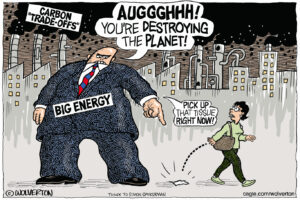U.K. Criminals Have Dramatically Decreased Their Carbon Footprint
A new study shows that the carbon cost of acquisitive and violent crime dropped by 62 percent between 1995 and 2015. Police flash a warning in a burglary prevention campaign in Britain's West Midlands. (West Midlands Police / Flickr)
Police flash a warning in a burglary prevention campaign in Britain's West Midlands. (West Midlands Police / Flickr)
By Tim Radford / Climate News Network
In the campaign to reduce carbon dioxide emissions and lower the energy costs of money-making, one shady group not famous for its social and environmental concern has made a significant contribution — with the carbon footprint of crime in the UK more than halving in two decades.
According to a study published in the British Journal of Criminology, the carbon cost of acquisitive and violent crime in 1995, was estimated at around 7 million tonnes, but was down to 3 million tonnes in 2015 — a drop of 62%.
It means that, in the course of two decades, the UK’s criminals have spared the atmosphere an estimated 54 million tonnes of carbon dioxide equivalent that would otherwise have contributed to global warming. And that is roughly 10% of the nation’s annual emissions.
It is, once again, a reminder that any unlawful activity – organised or impromptu – is big business, with consequences that extend far beyond the scene of the crime itself.
“All public bodies, organisations and businesses must reduce their carbon emissions wherever possible, so to ignore these carbon emissions risks crime prevention strategies being unsustainable,” says study leader Helen Skudder, a postgraduate researcher at the Centre for Environment and Sustainability at the University of Surrey.
“Our study has shown that the carbon emissions have fallen further than the rate of crime, with a 48% carbon drop observed alongside a 30% crime drop.”
As the scientists point out, crime levels have been falling, and the nature of crime has also changed.
The ram-raids on jewellers’ shops with a stolen vehicle, the squeal of tyres in police chases, the sudden calls for an ambulance, the stakeouts and hijackings and all the associated street theatre of crime have diminished. Many of yesterday’s armed robbers have switched to lucrative and less overtly destructive online fraud.
The study assumes that a high proportion
of the carbon footprint comes in replacing
stolen or damaged goods.
Research like this is complicated – criminals, for instance, can’t usually be quizzed about their energy use – and depends on calculations from the UK’s own Office for National Statistics.
The study makes no estimates of the carbon cost of online crime, and it assumes that a high proportion of the carbon footprint comes in replacing stolen or damaged goods — both in cases of recorded and unrecorded crime. So the authors concede that “this study is not without its limitations”.
But it also establishes that there is no straightforward relationship between the number of criminal offences and the carbon footprint of the criminal world.
It also points out that carbon dioxide emitted in anticipation of crime – in security, crime prevention, and insurance – is small compared to the impacts that follow any actual crime, such as in the energy costs of replacing property, helping victims recover their health, and mobilising the criminal justice machine.
“Compared to the social and economic impacts of crime, the environmental harms associated with crime may seem marginal,” the authors say, “but to overlook these impacts risks crime prevention strategies being unsustainable in the future.”
And, they add, there is a clear risk that the UK might miss its carbon reduction targets “if carbon emissions associated with crime and the criminal justice system are not reduced wherever possible”.
Your support matters…Independent journalism is under threat and overshadowed by heavily funded mainstream media.
You can help level the playing field. Become a member.
Your tax-deductible contribution keeps us digging beneath the headlines to give you thought-provoking, investigative reporting and analysis that unearths what's really happening- without compromise.
Give today to support our courageous, independent journalists.









You need to be a supporter to comment.
There are currently no responses to this article.
Be the first to respond.